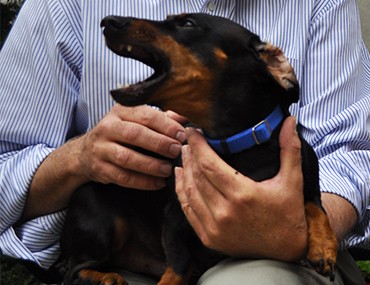Just like people, dogs are scared by all kinds of things. Most often, it’s a result of having a negative experience or not being properly handled when his natural fears surface.
First thing's first: what scares your pooch?
Most dogs are scared of something. Have you noticed what scares your dog? Is it children, men, women, people with loud voices, or people who are very tall? When your dog is out and about or when new people enter your home, pay attention to his reactions and try to figure out exactly what is making him anxious. He’ll probably give you some fairly clear signs:
- Growling or aggressive barking at the person or people making him feel nervous
- Cowering or other submissive behaviors like hiding behind you (which could also be accompanied by barking or growling)
- Pulling or lunging toward or away from the person making him scared
- Snapping or biting, which is the worst and most dangerous of fear-based reactions
- Inappropriate urination, a.k.a. “piddling”
The Don’ts
What should you do when your dog exhibits these fearful behaviors? Resist your natural inclinations. We’d all probably be tempted to coddle the dog and try reassure him or discipline and correct him, and while these seem like good ideas, what you’re actually doing is reinforcing his reaction and telegraphing to him the message, “you’re right, something is up and you should be nervous.”
- Don’t console him
- Don’t shout or yell
- Don’t jerk him away or tug aggressively on his leash
- Don’t force him further into the situation trying to let him know it’s OK
The Dos
If your dog has a fearful reaction, remove him from the situation calmly and without really acknowledging it at all. Just walk out of the room or away from what’s causing the stress. Once you’re clear of the situation, engage with your dog normally and get his focus back on you.
Next, think carefully about exactly what made him nervous and try to reengineer the situation so it’s positive for your dog. For example, if he was scared of the child who came into the room yelling, running, and making lots of noise, ask that same child to enter calmly and slowly and not pay any attention to your dog. Similarly, if he was afraid of your tall, deep-voiced male friend, ask that friend to enter the room quietly and calmly, ignoring the dog, and have a quiet, friendly interaction with you. Your dog will pick up on your comfort and that will be a step towards being comfortable himself. During these reintroductions, make sure your dog doesn’t feel forced into the situation or trapped. And when he starts to get anxious, give him a break.
Keep trying these reintroductions to stressful situations and see if your dog begins to relax. You can also introduce treats into the mix and that can help make a positive association with the person or people who are scaring him. You can even have the person he’s afraid of begin to give treats, even if it’s just tossing them to the dog from across the room.
This is often a somewhat slow and incremental process. Don’t rush it; it can take time to change your dog’s natural reaction.
Prevention
As in the case of any negative behavior, prevention is better than treatment. We recommend socializing your dog in a wide variety of situations. Puppies are actually much more flexible and open to things than adolescent or adult dogs (just like human children). Let your puppy meet your friends, the neighborhood kids, the noisy people who live upstairs – he should become accustomed to what is normal in your life so it will become normal for him, too!
As always, if your dog is having a hard time overcoming this or any problem, give your veterinarian a call, as your vet is the best partner you have in ensuring your pooch is a happy, healthy, and well-adjusted part of your family.
